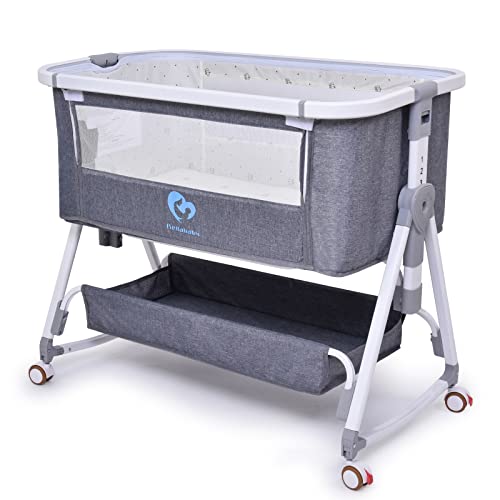11 “Faux Pas” That Actually Are Okay To Create Using Your Bedside Cot For Infants
The Importance of Bedside Cots for Infants: A Comprehensive Guide
As new parents embark on their parenting journey, they are faced with a myriad of choices concerning their infant's sleep arrangements. Amongst these options, the bedside cot stands apart for its myriad of advantages. This article explores the significance of bedside cots, discusses their advantages and disadvantages, responses often asked concerns, and includes a comparative table to assist parents make informed decisions.
What Is a Bedside Cot?
A bedside cot is a sleep space developed to be positioned next to the parents' bed, permitting easy access to the infant during the night. These cots feature adjustable height settings, allowing them to line up with the height of the adult bed. Frequently, they can be attached safely to the bed or remain nearby, supplying a safe yet available sleep environment for the baby.
Types of Bedside Cots
- Co-Sleeping Cots: These cots connect securely to the parents' bed, enabling close distance while making sure the baby has their own safe sleeping space.
- Freestanding Cots: These are positioned next to the bed but do not attach straight. They still provide a convenient reach for feeding and reassuring.
- Portable Cots: These cots are lightweight and developed for travel, typically including collapsible designs and easy-transport capabilities.
Advantages of Using a Bedside Cot
Bedside cots provide a number of advantages that can improve both the infant's sleep experience and the parents' peace of mind. These consist of:
1. Boosted Safety
According to the American Academy of Pediatrics (AAP), having the infant sleep in the same room as parents, without sharing the very same sleeping surface, substantially lowers the danger of Sudden Infant Death Syndrome (SIDS). A bedside cot uses a safe space while keeping proximity.
2. Easier Nighttime Care
When a baby is within arm's reach, feeding, diaper modifications, and reassuring becomes much more convenient. Parents can rapidly relieve their infant without completely waking from sleep or leaving the bed.
3. Support of Bonding
The close distance provided by a bedside cot motivates bonding during nighttime feedings or soothing. This can promote a complacency for the infant and help establish more powerful psychological connections.
4. Space-saving Design
Numerous bedside cots are created to be compact, making them perfect for small home where a full-sized crib might not fit. They can be quickly moved or stored when not in use.
5. Versatile Functionality
A lot of bedside cots can be adjusted in height and typically include removable sides, making them versatile for different usages as the child grows or family requires change.
Drawbacks of Bedside Cots
Despite their benefits, there are some drawbacks to consider when picking a bedside cot:
1. Minimal Lifespan
Bedside cots generally have a much shorter life expectancy than basic cribs, often accommodating infants only approximately a particular weight or height. Parents might need to shift to a full crib earlier than expected.
2. Stability Concerns
If not securely attached or properly placed, a bedside cot may present safety concerns. Parents should guarantee that the cot is steady and well-aligned with the bed.
3. Change Period
Some infants may take some time to get used to sleeping in a cot, particularly if they are utilized to closer contact. Parents might need to be client as their kid adapts.
How to Choose the Right Bedside Cot
When picking a bedside cot, parents must think about the following criteria:
- Safety Standards: Ensure the cot adheres to all safety guidelines.
- Adjustability: Look for height-adjustable functions that align with your bed.
- Construction Material: Choose a cot that is strong and made from non-toxic products.
- Relieve of Use: Opt for styles that enable one-handed operation when accessing the infant.
Table: Comparison of Popular Bedside Cots
Feature
Co-Sleeping Cot
Freestanding Cot
Portable Cot
Attachment to Bed
Yes
No
No
Adjustability
Yes
Yes
Yes
Travel-Friendly
No
No
Yes
Life expectancy
6-12 months
18-24 months
0-12 months
Cost Range
₤ 150-₤ 300
₤ 100-₤ 250
₤ 50-₤ 150
Often Asked Questions (FAQs)
1. Bedside Cot For Safe Sleeping cots safe for my baby?
Yes, when utilized properly and according to security standards, bedside cots are safe for infants. It is essential to make sure that the cot is firmly located and does not position any risk of falling.
2. At what age can I transition my baby from a bedside cot to a crib?
A lot of parents shift their baby from a bedside cot to a crib between six months and 2 years, depending upon the infant's growth and convenience level.
3. Can I use a bedside cot for twins?
While some bedside cots are created to accommodate more than one kid, the majority of are meant for single infants. Parents of twins might need to think about using different cots.
4. How do I keep my bedside cot?
Regular cleaning, examining for wear and tear, and making sure that all elements, such as security straps and mattress, remain in great condition, can assist preserve your bedside cot.
Picking the right sleep arrangement for an infant is among the many choices that new parents deal with. A bedside cot offers unrivaled convenience and safety while enabling close adult interaction. Comprehending the benefits, downsides, and features of bedside cots can empower parents to make the ideal option for their household's needs. By weighing these factors together with safety preventative measures, parents can produce a nurturing sleep environment for their kids.
